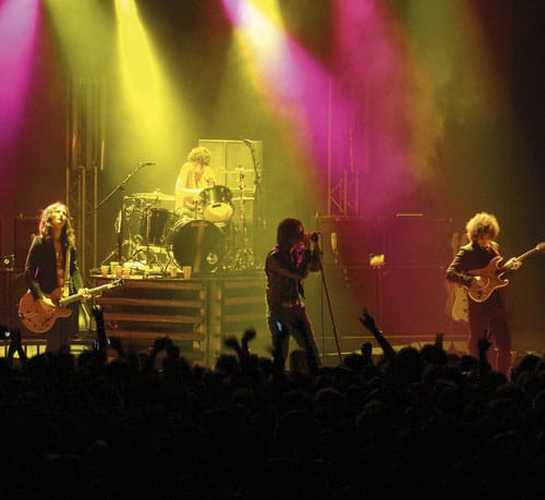DIFFERENT STROKES
The Strokes brought their angular downtown Manhattan guitar sound to the UK in February - teaming up with their long-serving British sound engineer, James Gebhard for a theatre/arena tour.
Though their latest album, First Impressions of Earth, is more experimental and lavishly produced than the lo-fi approach of the first two, the band likes to capture the rawness of those early recordings in a live context. However, their FOH man strives to transmit a much greater energy than was present in the studio mixes. 'Raw, loud and in your face,' is how James puts it.
The crew line-up on this tour saw him paired with Capital Sound's experienced systems tech Al Woods for the first time - perhaps surprisingly, since Gebhard has himself long been a massive fan of Cap's equipment inventory, and the support he knows he can depend on. Most of Cap's Martin Audio line array fleet has been called on at some stage during this tour, depending on the venue size and configuration.
'The W8L/LC is my preferred system of choice,' exclaims Gebhard. 'Martin is always the first name on my spec - which is why I use Capital, apart from the great working relationship I have with them.'
The sound engineer has been with The Strokes since the very beginning and five years later James Gebhard (below) still masterminds The Strokes' live sound with a largely transparent approach, restricting any processing to a minimum. 'I use a bit of reverb and delay - largely because the new album has it - and I use the Avalon preamps on Julian (Casablancas') vocals for distortion on the older songs; but that's it.'
The latest tour has seen the band play a variety of theatres and arenas, but because of the extra lighting that production has been carrying - with a mother grid and separate triangular truss - it has restricted their ability to fly the system. 'In certain venues it's been difficult to get the weights I have needed to fly the necessary amount of PA, due to roof loadings,' says Al Woods. 'It's a relatively heavy lighting rig for some of the venues, which can eat into the weight available to hang PA. However, the W8LC is a very light, powerful box and is a great choice for a flown system in these situations.'
Having overcome the physical obstacles, he has then needed to optimise the two main PA hangs for the house and tune them to the sound engineer's requirements. Though he carries Martin's predictive ViewPoint™ software on his laptop, along with XTA AudioCore V6 (DSP) and SIA Smaart (for time alignment and phase checking), so familiar is Al Woods (right) with system and house characteristics that he draws largely on personal experience.
Although he says ViewPoint provides a great guideline, like all system engineers, where tiered balconies are involved, his concerns turn to the thermal effect a house full of standing punters will have on the predictive curves and the tendency for the high and midrange energy to shoot over their heads. 'So with the flown W8LC's it's a case of redistributing and attenuating the energy, taking more from the balcony by tightening up the splay angles, generally from the FOH position to the rear of the floor.' Touring with both Starsailor and the Stereophonics helped him to evolve this solution.
Meanwhile, both he and James Gebhard have nothing but praise for the response of the W8L. 'When they first introduced these boxes I was really blown away, it just has such great attitude,' said the FOH engineer.
'Other line array systems may sparkle but sometimes they are just too 'polite'', cut in Al. 'The Martin system has always had a really raw energy to it, especially at the low end. I don't think there's another system that comes near it in the transition between the midrange and the low end. On the L, especially, the low end is stunning - it's pure rock 'n' roll; but having said that I have mixed orchestras with it and achieved great results.'
Throughout the tour, production has been reconfiguring the systems, using both the W8L and W8LC as the main hangs, adding outfills and sidehangs, and where necessary they have used Martin's dedicated W8LD downfill box. At Hammersmith they introduced the W8LM mini line array for infill purposes.
At the stage, monitor engineer Jamie Landy provides eight monitor mixes via the 12 Martin LE700C's - having been converted to Martin's classic wedge after using them while working with the Futureheads on the NME 2005 tour. A W8C/S218 sidefill stack keeps the sound focused on stage. 'Nicolai (Fraiture) has a lot of kick to his bass,' says James, 'and so the S218's were recommended - and he's not kicked his wedges off the stage yet.' A further stage mix is sent to the W2/W2SA drum fill combo for the benefit of Fab Moretti.
The Strokes change their show and running order on a nightly basis. 'There was a time when they didn't do set lists at all - and they rarely soundcheck,' informs James Gebhard. But on this sell-out tour they continuously built their show to a crescendo, ending with the three classic tracks from their first album, New York City Cops, Barely Legal and finally Take It Or Leave It.
